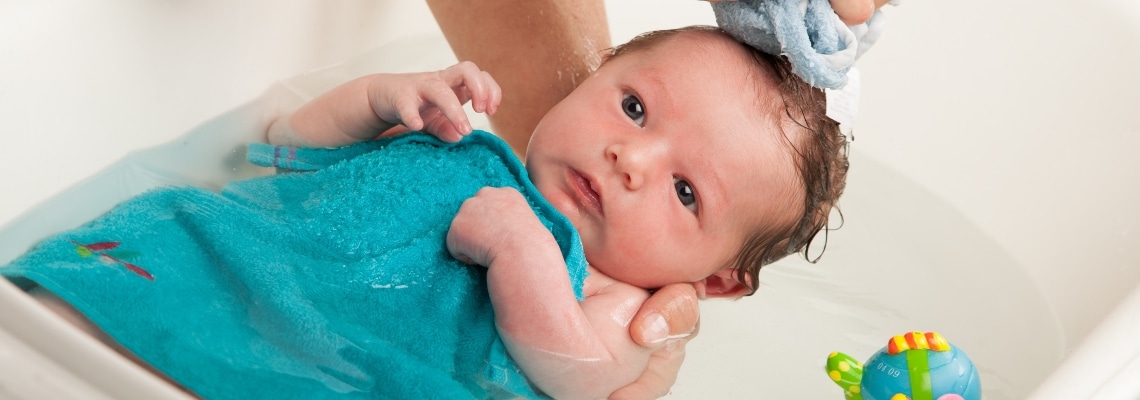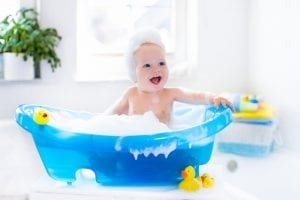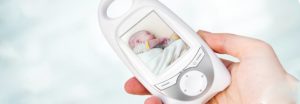
Bath time takes on a whole new meaning when you bring a newborn home. While as adults, it is a fairly simple idea, with babies there is a lot more to consider and keep in mind. If you are a first time parent it is especially important to take the time to learn about bath safety and some tips to help make it all go smoothly.
When Baby First Comes Home
It is important to follow the doctor’s orders when you first bring your newborn home. Many doctors will have you avoid using a baby bathtub and submerging the baby’s body until after the umbilical cord has fallen off on its own. This can take anywhere from one to four weeks to heal after birth. This also applies for if you have circumcised your baby, as that will need one to two weeks to heal too.
During this time period it is best to give your baby a sponge bath with patience and light pats. Select a safe, flat surface in a warm room to give your sponge bath. You could use areas such as the floor, counter, or a changing table. Have a bowl with warm water nearby, or fill the sink with water you will use.
Undress the baby and wrap them in a towel. With a washcloth that is dampened with water only, you can wipe your infant’s eyes from the inner corner to the outer corner. Then wash their nose and ears with the damp washcloth.
Once you have done that, you can add a little soap to the cloth and wash their face gently then pat dry. With baby shampoo you can then create a later and wash your baby’s head. Using a new wet cloth you can rinse the baby off and gently wash the rest of the baby. Make sure to pay extra attention to the creases around the neck, under the arms, behind the ears, and genital areas. Make sure that your baby is gently pat dry once you are done and then diaper and dress your baby.
Baby Bathtub Time
 Once the baby’s umbilical cord and/ or circumcision have healed, then you can begin to use your baby bathtub. Baby bathtubs are smaller tubs that fit inside of a larger bathtub to help decrease the space that you are putting your baby within and keep them safer and easier to manage. It is best to choose one with a contoured design or an internal sling to help hold baby in place. It is best to avoid a bath seat, as these can easily tip over and can trap your child underwater.
Once the baby’s umbilical cord and/ or circumcision have healed, then you can begin to use your baby bathtub. Baby bathtubs are smaller tubs that fit inside of a larger bathtub to help decrease the space that you are putting your baby within and keep them safer and easier to manage. It is best to choose one with a contoured design or an internal sling to help hold baby in place. It is best to avoid a bath seat, as these can easily tip over and can trap your child underwater.
Temperature
It is important to make the bath water the right temperature. You can fill the tub with two – three inches of lukewarm water. The water should be no more than 120 degrees fahrenheit. You can test the temperature with your wrist or your elbow to make sure that it is not too hot. Make sure that the water is no longer running in the tub.
Bathing Process
Undress your baby and place them into the water immediately. Try and make sure that the room is warm to help avoid chills. Make sure to use one of your hands to support your baby’s head and the other to guide the baby in feet-first. Talk and comfort your baby as you are placing them within the bathtub.
Then grab a washcloth to wash their face and hair. You can gently massage your baby’s scalp with a soft baby hairbrush or the pads of your fingers. When you rinse the shampoo or soap from the baby’s head, make sure to cup your hand across their forehead so that it does not get into their eyes. After washing their face and head first you can then add more soap to the wash cloth and continue washing the baby’s body.
During the bath, try to pour water gently over your baby’s body so that they do not get cold. After you have finished, make sure to wrap your baby up in a towel immediately covering his or her head within it.
How Often
Your baby does not need a bath every day. Around two to three times a week is fine as long as you clean their face, hands, neck, and diaper area daily. In fact, it is recommended to bathe your baby only a few times a week throughout their first year to help avoid drying out their skin.
What Soap to Use
It is important to look for products that do not have added perfumes or dyes within them, as these can irritate sensitive skin. Many products are both baby shampoo and body wash these days. When looking for the right soap make sure to look for brands that are more natural and geared towards infants.
Helpful Tips for Bath Safety
As a new parent you are learning so many things for the first time. Here are some tips to help make the entire process a little easier:
- Try and make sure to have everything that you will need within arm’s reach. This will help you keep one hand on your baby at all times.
- Make sure to empty the tub completely immediately after each use. A baby can drown in as little as one inch of water.
- Place a non skid mat beneath your baby tub to help prevent it from slipping.
- Try learning infant CPR. This will help to ease your mind and keep you prepared in case you ever need to use it.
- Never leave your baby unsupervised for even a second. If something interrupts bath time that you can’t ignore, wrap your baby up in a towel and bring them with you.
- Put a cushion over the water faucet so that your child will not be hurt if they accidentally bump their head against it.
- Keep the toilet lid shut at all times. This is moreso for toddlers, but once they begin walking they can become curious and try to play in the water. It is best to avoid this so they do not lose their balance and fall in.
- Be sure to unplug all appliances near the bathtub during bath time. This will help to avoid anything accidentally falling into the tub or on your infant.
Enjoy the Time
While bath time can seem worrisome and cause anxiety, when taking the proper precautions and putting safety first it can become a bonding time that you enjoy with your new baby.


